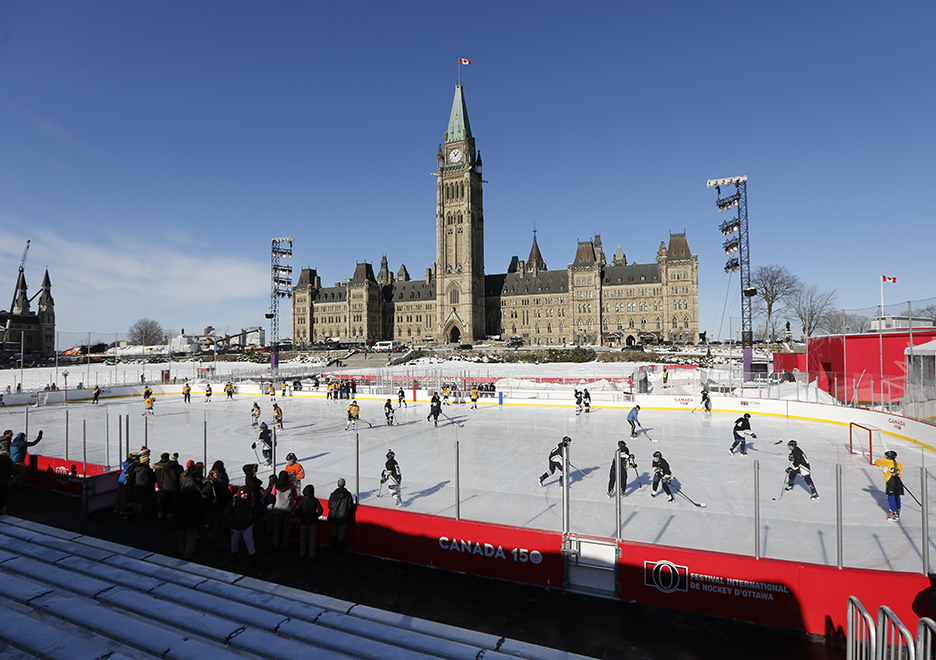Canada 150 rink opens door for future events on Parliament Hill
By Jacob Hoytema
It began life as perhaps the country’s most controversial sporting venue — a $5.6-million skating pad on Parliament Hill that was initially planned to last for only three weeks in December, a grand finale to the country’s 150th birthday celebrations.
But under fire from critics, Heritage Minister Melanie Joly extended the life of the Canada 150 Rink to the end of February, and it ended up hosting dozens of hockey games and more than 150,000 skaters for a bout of winter fun — producing countless selfies with a Peace Tower backdrop.
Now, the issue of the rink’s cost-effectiveness has given way to another question: What will three months of daily public activity in front of the national legislature mean for the future of Parliament Hill?
Less than four years ago — in the wake of the October 2014 shooting in which gunman Michael Zehaf-Bibeau killed a ceremonial guard at the National War Memorial before storming into Centre Block and dying in a hail of bullets — many observers feared Parliament Hill would become a no-go zone for the public. The day after the shooting, the BBC asked “Can Canada preserve its openness?” and wondered aloud whether the shooting might mean an end to the remarkable level of public access to Parliament Hill that Canadians have enjoyed.
But now, Parliament Hill seems to be entering a new chapter in its rich history, emerging as a vibrant event venue for Ottawa. Along with the popular Yoga on the Hill sessions in the summer and evening light shows, Senator Nancy Greene Raine — 1968 Olympic skiing champion — organizes annual “Ski Day on the Hill” events to promote healthy active living, with locals welcomed to cross-country ski on the snowy lawn of Parliament. The event has “grown tremendously every year,” according to Greene Raine.
After the rink closed down on Feb. 28, the Department of Canadian Heritage revealed that it had been visited by 152,089 people over 882 public skating hours, plus many more for programmed events like youth hockey tournaments.
The department also stated that the “final cost breakdown will be available in the coming months.”
It’s something of a surprise that the rink came to exist at all. It began as a dream of the Ottawa Senators and Ottawa Mayor Jim Watson, who had hoped that the respective bureaucracies of the National Hockey League and the Canadian government would collaborate to allow an official game on Parliament’s front lawn to mark the 100th anniversary of the NHL .
After months of media speculation, Joly’s office announced that the game would be impossible due to Hill regulations forbidding food and alcohol sales, organized sporting events, fixed structures and signage, to name a few of the impediments.
But the idea was reborn as the Canada 150 Rink, which, as a structure adorned in signage that hosted organized hockey games, still breached many of these criteria. Canadian Heritage broke new ground in tiptoeing around these protocols — and after the apparently positive reception for the rink, it’s clear Parliament Hill has emerged as a popular public space.
“The strong uptake on using the Canada 150 Rink,” Joly’s ministry stated in a press release, “is a good indication that Canadians and visitors were excited to go out and experience such a unique opportunity, skating on Parliament Hill.”
While there’s been a recent resurgence of public activity on Parliament Hill, the public square in front of Centre Block was traditionally an important gathering place, notes a local historian.
“Parliament Hill always seems to have been used for public events,” said Bytown Museum curator Grant Vogl, listing 19th-century Dominion Day celebrations, crowds of public mourners for Queen Victoria’s death in 1901 and military ceremonies as examples.

